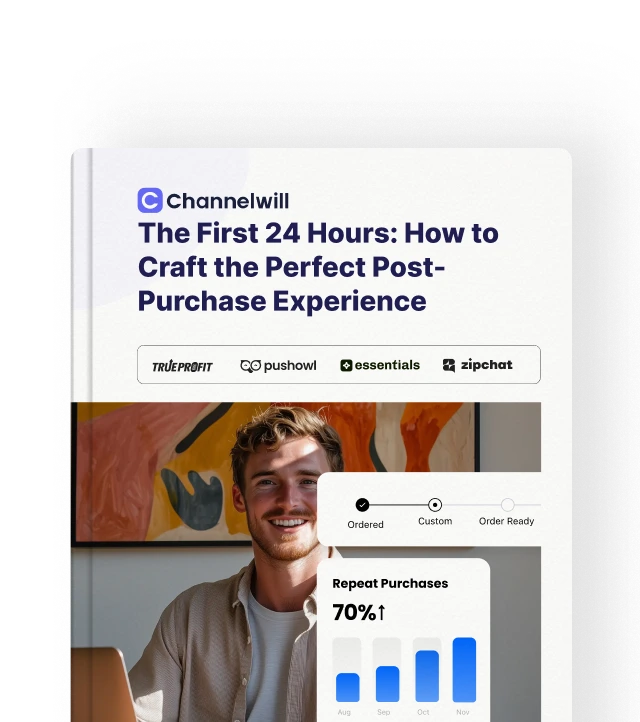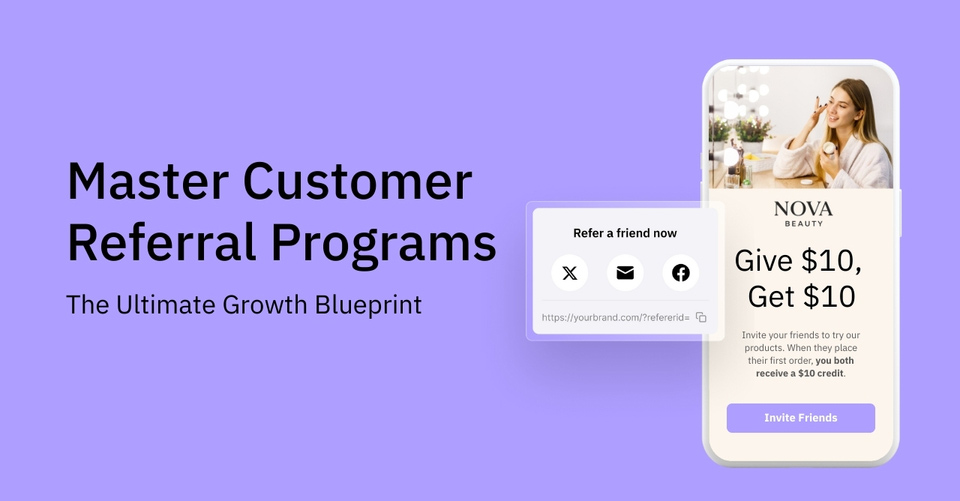In 2013, Allbirds was just an idea. Fast forward to 2025, and it’s worth $105M. Your Shopify store can reach that level too. You just need a strong marketing plan.
Start by picking the right marketing channels. Promote your products on key platforms. Turn your subscribers into loyal customers.
In this blog post, we’ve shared the top 23 best Shopify marketing strategies for your e-commerce business in-store. These insightful tips will help you grow your store. Get ready to take your store to new heights!
What is Shopify Marketing?
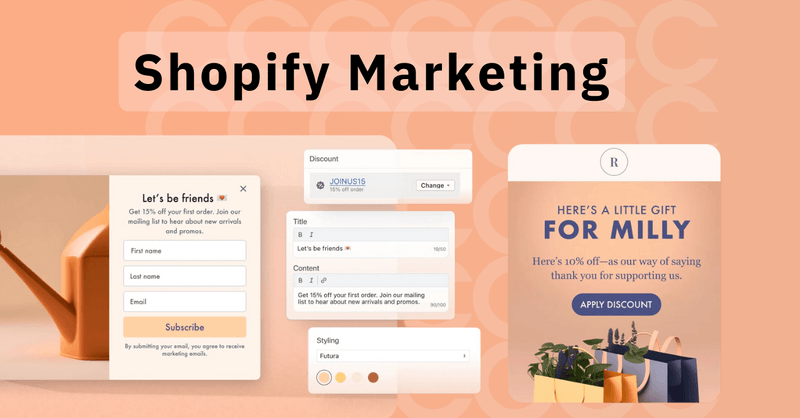
Shopify marketing is a set of marketing strategies and tactics to promote products or services on the Shopify platform. It helps businesses set up and run an online store. The goal is to attract customers, boost brand awareness, and increase sales.
A study by Google reveals that 53% of consumers research online before making a purchase. This emphasizes the importance of a strong online brand presence. Effective marketing makes such a presence possible.
Marketing on Shopify includes various activities. One key strategy is SEO, which improves a store’s visibility in search results. Pay-per-click PPC advertising drives targeted traffic to the store. Social media marketing helps connect with target customers. Email marketing is great for keeping customers all in.
Content marketing is another important part. It builds brand authority and educates customers. This can be done through user-generated content, like reviews and helpful guides for shopping. All of these tactics together grow a Shopify business and enhance the customer experience.
Benefits of Shopify Marketing
Extensive App Marketplace
Shopify has a very large app store. There are many marketing tools that can be used to improve business stores. Such apps include email marketing, social media integration, and customer engagement apps. This versatility is an asset as it makes it possible for businesses to seek solutions that suit their nature of operation
Easy-to-Use Tools
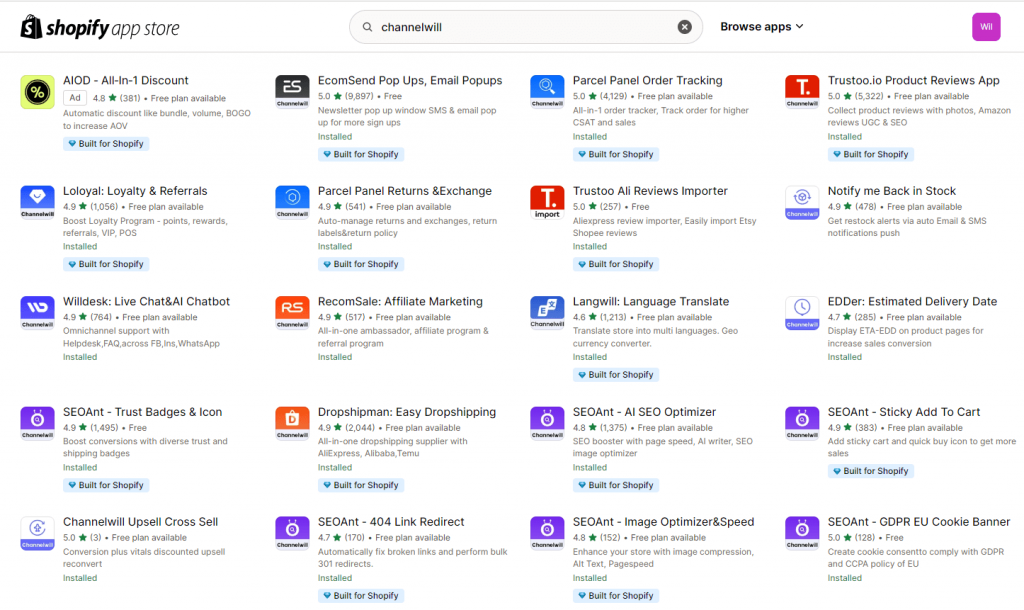
Shopify provides user-friendly marketing tools that even beginners can use. You don’t need to be an expert to run campaigns. Shopify allows you to set up email marketing, create social media ads, and track results—all from one platform.
Targeted Marketing
Shopify empowers you to run targeted marketing campaigns. You can reach specific customer groups based on preferences, location, or purchase history. This approach boosts the chances of converting visitors into satisfied customers. Additionally, Shopify’s built-in analytics enables you to track your marketing efforts. You can easily monitor campaign performance and make informed decisions to optimize your budget.
Mobile Optimization
As the number of consumers using their mobile devices to shop increases, mobile responsiveness is important. Shopify themes are responsive and, as such, they are optimized for viewing on mobile devices. This helps to make sure that online stores are good to look at and easy to use on smartphones and tablets. Mobile-friendly sites increase the chances of making sales and the overall experience of the users.
Excellent Customer Support
Shopify provides customer support services throughout the year, that is, throughout the year. Companies can get support through phone calls, emails or through the live chat option. This support makes it easy for the users to solve any problem that they face. Quality customer service improves the quality of the experience and helps businesses to concentrate on marketing strategies.
Top 23 Shopify Marketing Tips
If your Shopify store has high visits but low conversion rates, it might be time to rethink your marketing strategies. Gaining sales requires more than just traffic. You require a strategy that converts the web visitors into customers.
For new and old Shopify users, it is very important to pay attention to the right methods of marketing for the growth of the business.
Here are 23 of the best marketing tips to assist with increasing your sales in this article. These are all strategies to get traffic and conversions, whether it is about your website or your social media advertising. You can apply all these tips to your store and see how your conversion rates will improve.
For Site Optimization and Engagement
1. Create sticky banner
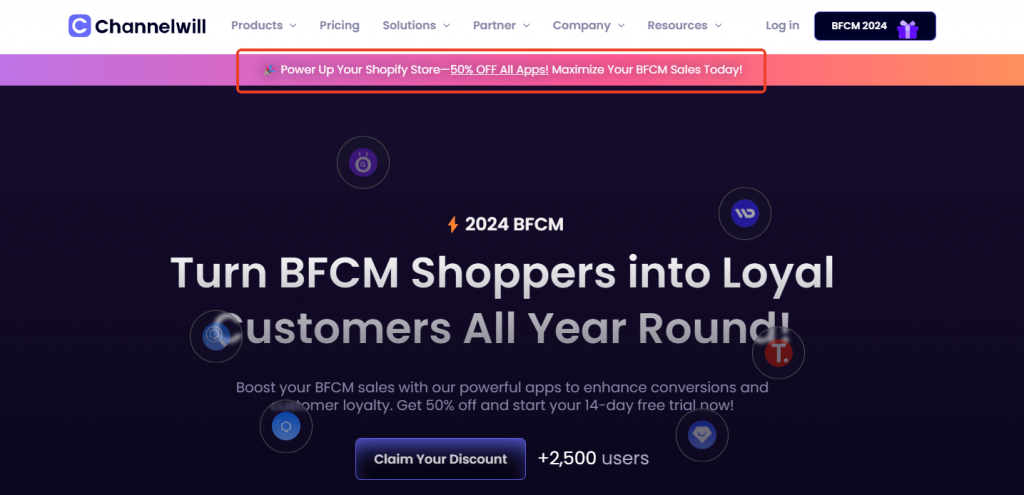
A sticky banner boosts visibility on Shopify, but you’ll need a special app to enable this feature for maximum impact. It remains on the screen as customers scroll through it, compelling the customers to act. Two popular types of sticky banners are often used in stores.
The first one is a sticky shopping cart. This allows the customers to locate the cart from any page, reducing cart abandonment. This makes the process of checkout very seamless.
The second is an announcement bar. It is fit for sharing promotions or any new development. If your store targets customers in the European Union, use the announcement bar for GDPR messages. This will ensure compliance and customer loyalty at the same time. Each banner improves the shopping experience and increases sales.
2. Add targeted popups
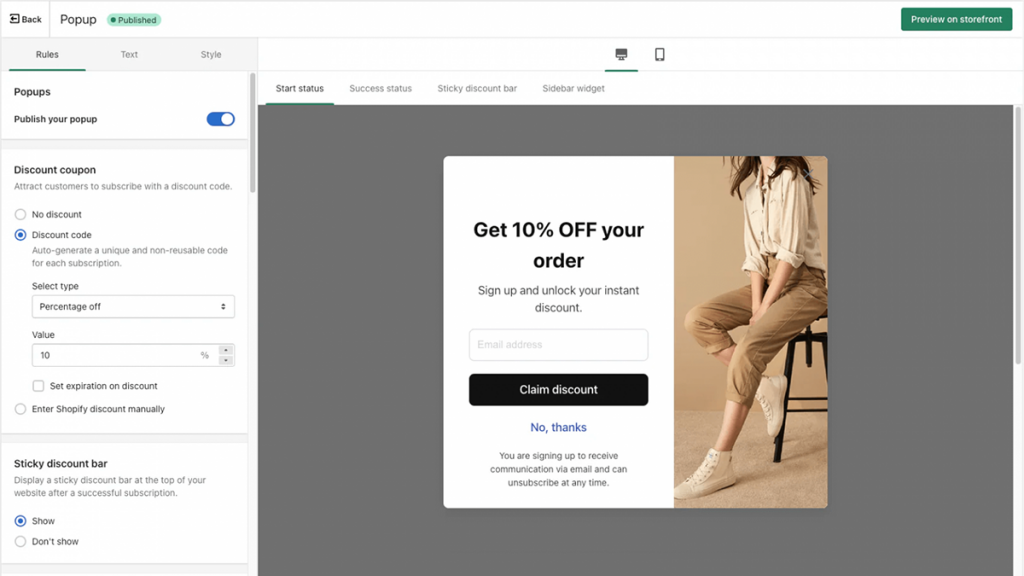
Targeted pop-ups can increase Shopify sales dramatically, engaging visitors based on their behavior. For example, exit-intent popups attract eyeballs as the visitor is about to leave. These pop-ups offer attractive discounts and give them a reason to stay.
First-time visitors are welcomed by pop-ups. These calls are for special promotions or ask the visitors to join the newsletter. Such small but timely pop-ups can really go a long way.
The timed popups appear on the page after the visitor spends some time on the page. They display suitable ads when the users are most online.
Popups boost the conversion rate by as much as 9.28% according to OptinMonster. Strategically, pop-ups are attention-grabbing without being intrusive. With the right targeting, they compel the visitors to take action. This makes them a very useful and valuable tool for increasing engagement and sales.
3. Live chat
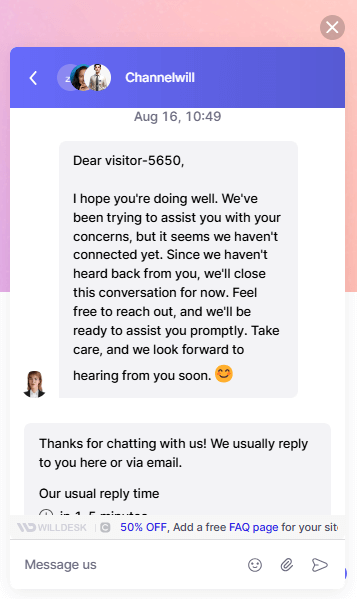
According to research done by Gorgias, integrating live chat to your e-commerce site can increase your conversion rates by 12%.
For instance, a chatbot can recommend products based on a customer’s history of interaction with the website or show products that are frequently bought. This kind of interaction helps to make a sale since it is made one-on-one.
Chatbots help enhance customer relations by offering round-the-clock assistance, thus freeing the team to handle more complicated cases.
Even more interesting, 62% of customers are inclined to choose live chat rather than waiting for a human agent. The average revenue per brand that implemented the Gorgias chat widget in 2021 was $38,702 from chat.
4. Currency switcher for global customers engaged
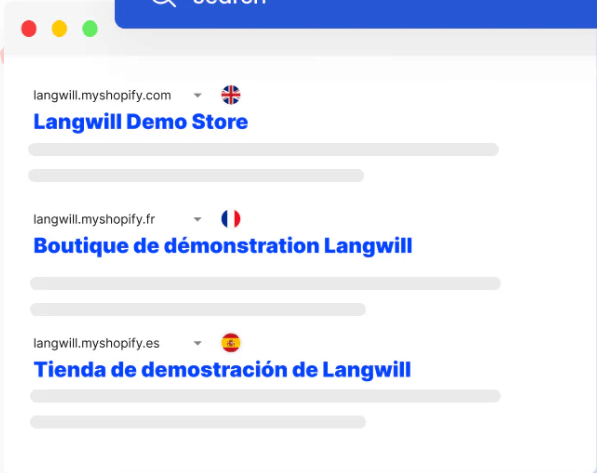
A currency switcher is vital for businesses that serve global customers. It lets users view prices in their local currency. This improves their shopping experience.
For example, a customer in the UK can switch from USD to GBP. They can see the exact price they need to pay. This helps them avoid confusion and unexpected fees during checkout. Offering this feature shows your business understands customer needs. It also shows you care about their convenience.
When customers see prices in their currency, they trust the store more. This makes them more likely to buy. The switcher eliminates the need for manual conversion. This makes the buying process smoother and faster.
5. Display the product reviews
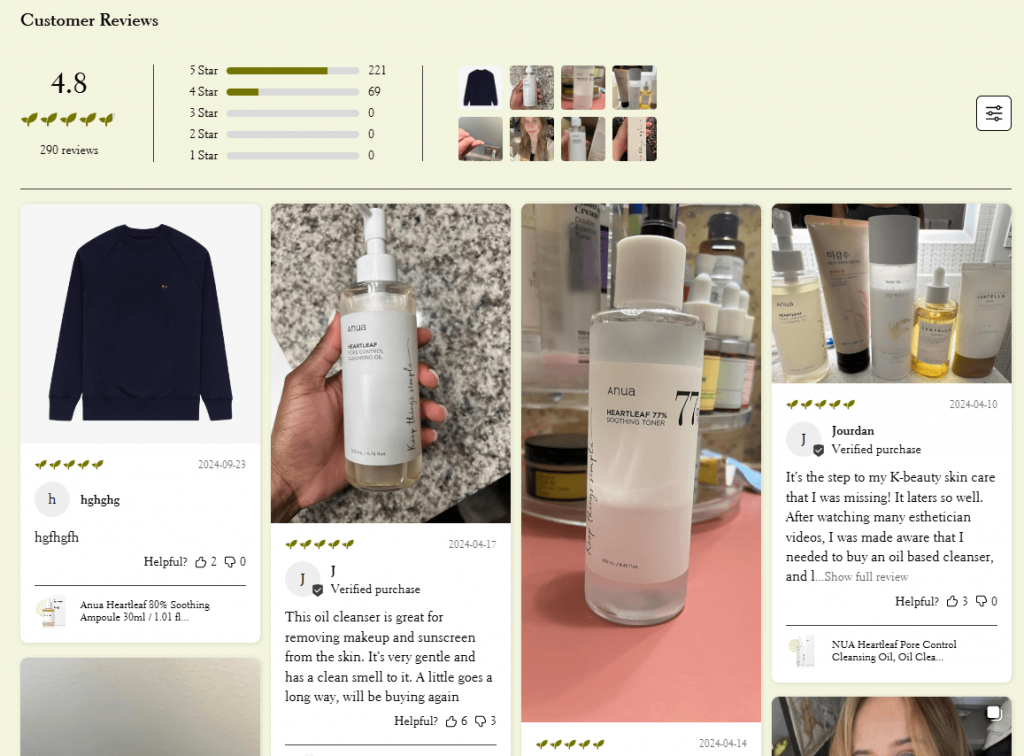
Sharing product reviews is one of the best ways to increase your Shopify store’s credibility. People believe in word of mouth. The positive reviews are likely to help convince the new visitors to buy something. Gymshark, for instance, has customer reviews displayed at the top of the page for every product. This practice creates a sense of community and trust around your brand.
Negative comments also contribute to this. They help give your store credibility. Responding to these reviews shows you value their feedback. Incorporating a star rating system in your app can help users quickly gauge product quality. However, most app systems already feature starred reviews. To stand out, consider introducing unique product features to your customers:
Import from AliExpress: You can import 50 items at a time, with no cap on the total.
Get More Reviews: Collect reviews through imports, emails, social media, and other channels.
Translate Reviews: Automatically switch languages to cater to a wider audience.
Additionally, tools like Trustoo.io automatically gather reviews with photos from your customers. You can display these reviews in beautiful widgets, making it easy for potential buyers to see product feedback.
6. Speed up your site page

Site speed can make a massive difference in the users’ experience. First, optimize images to reduce their file size without losing quality. For automatic image optimization, use SEOAnt image optimiser.
For enhanced efficiency, SEOAnt provides a robust Content Delivery Network (CDN) feature. This assists in loading your site faster by serving it from a location closer to your visitors.
Also, do not load up your website with large applications that cause the traffic to lag behind. Regularly review and remove unnecessary apps to improve loading times. A great user experience and longer dwell time boost your brand image, leading to higher conversions and customer satisfaction.
For Email Marketing Strategies
7. Grow your email marketing list
Building your email marketing list is important for your Shopify business. Start by offering a discount or free shipping to the visitors, to encourage them to join the list. For instance, you could offer them 10% off their first purchase for subscribing to your list. This not only generates sales but builds loyalty.
Email marketing keeps audiences engaged with newsletters, sharing tips, updates, or special offers. Expanding your mailing list boosts potential customers. Brands like Sephora offer exclusive deals for sign-ups, leading to higher engagement, sales, and revenue growth of up to 30%. You can also use PopUp Forms on your website. Interact with your audience often so that you can inform them on new products and or promotions.
8. Back in stock notification
Back in stock notifications make customers active again. When a product is out of stock, customers can subscribe to the product. For example, a clothing website can alert customers to a notification when a particular dress is restocked. This makes people feel pressed to make the purchase. Therefore, it leads to quicker purchases.
The other effective way is to make these notifications more personalized. Use customer data to recommend other related products that are restocked. If a customer has signed up for a notification on a shoe style, suggest the complementary handbag. This approach enhances customers’ experience.
9. Auto-email notification
An effective marketing strategy relies heavily on auto-email notifications. These emails provide real-time updates on order logistics. This ensures customers stay informed about their purchases. They can also be customized to include product recommendations. This entices customers to explore additional purchases.
Once the order is delivered, another automated email can be triggered. This prompts customers to leave a review. To boost engagement, consider offering incentives. These could include coupon discounts or even a customer loyalty program with points. These strategies not only improve the customer experience but also encourage repeat business. They enhance overall satisfaction as well.
10. Create email templates
Email templates are critical for successful marketing on Shopify. Research shows that personalized emails have a higher open rate, often exceeding 25%. For example, businesses that use segmented email campaigns see a 14% higher click-through rate than those that do not. Well-crafted email templates help maintain consistent communication.
Here are some email template types:
Welcome emails provide the first impression of your brand to new customers. They often have a special discount.
Advertisement emails focus on the sale and new products. These emails persuade the customers to make the purchase.
Abandoned cart emails remind shoppers about items they left behind. They can increase sales by providing a reminder or even a discount.
Newsletter templates share information, tips, and news. They help to retain and update customers
11. Create multichannel marketing automations
Creating multichannel marketing automations is an effective way to enhance your Shopify marketing strategy. This approach allows you to engage customers through various channels, such as email, social media, and SMS marketing. For example, platforms like Klaviyo help automate these interactions. You can set up personalized messages based on customer behavior. This ensures timely communication and saves time. As a result, customer engagement is boosted.
Willdesk takes this a step further. It integrates information from multiple marketing channels. This unifies the management and processing of customer data on a single platform. By simplifying your marketing efforts, you can achieve better results.
For Content Marketing Strategies
12. Use AI tools
AI tools have made Shopify marketing strategies easier. Marketers have embraced AI in their work. A 2023 Instapage survey found that 95.8% of marketing professionals use AI, with 55% including it in their workflows for social media and content generation. AI tools create images, design beautiful pages, and generate outlines. They can also write product descriptions, meta descriptions, and blog articles. This allows businesses to save time and focus more on growth.
For instance, to write content, there are Jasper and ChatGPT. Canva uses AI to create visuals for your store. This way, AI increases productivity. Such tools can easily develop professional and attractive promotional materials without technical skills.
13. Search engine optimization
SEO is vital for your Shopify store’s success. It helps your website rank higher on search engines. When your site appears at the top, more people can find it, leading to increased traffic and sales. To create high-quality and readable content, it’s crucial to focus on value over volume. Relying on AI-generated bulk content can backfire; Google’s algorithm identifies low-quality material and penalizes sites employing this strategy.
For instance, some e-commerce sites initially experienced increased traffic through AI-generated content. However, following a Google algorithm update, these sites suffered significant ranking drops. This underscores the importance of prioritizing quality over quantity.
To improve ranking, create high-quality and readable content. Start with the search for relevant keywords to your product. Tools like Google Keyword Planner can help you find relevant keywords with good search volume. Use these keywords where possible in your product descriptions and blog posts.
Moreover, make sure your website is user-friendly. Improving website performance, ensuring proper indexing, and running a website audit for tech errors will enhance user experience and rankings.
A well-structured site is easier for users to navigate. Optimize your images with descriptive file names and alt text to improve SEO and enhance user experience. Regularly monitor your website’s performance using tools like Google Analytics to track visitor behavior and make necessary adjustments.
To improve your SEO strategies, try SEOAnt. SEOAnt provides an all-in-one toolkit to supercharge your website’s performance. It features auto page speed optimization, AMP, and image compression for faster loading times. Its AI-driven SEO booster generates meta tags and conducts competitive keyword research. Plus, it detects 404 errors and creates engaging product descriptions in seconds!
14. Multilanguage content marketing
Multilanguage content marketing offers significant benefits for businesses aiming to reach diverse audiences. By creating content in multiple languages, companies can enhance their visibility. This helps them connect with potential and existing customers more effectively.
Rock Content, a marketing company in Latin America, was able to grow its customer pool. They began with a highly active marketing blog in Brazil and Portugal. To expand even more, they developed a Spanish blog and started content personalization. This strategy brought 400,000 new monthly visitors with more than $1m of revenue. Today, their Portuguese blog is increasing at a rate of 100% per year. The Spanish blog records a stunning growth of 500 percent.
Formerly Langwill, Langwill is an AI-based application that translates and converts currencies for your Shopify store. This one adapts to the customer’s local currency depending on the location. To create a familiar shopping experience for international customers, Langwill has multiple languages and multiple currencies.
For Referral and Retention
15. Create a flexible and inclusive rewards program
Initiating an inclusive reward program can boost customer loyalty. For instance, Starbucks or Khaadi offer customers some incentives for more purchases, newsletter subscription, or sharing on social media. These programs have an open-door policy on the spending levels in order to increase participation.
To make it even more effective, let the customers select what they want. They could choose between discounts, special offers, limited items, or early birds sale like Daraz VIP offers. If customers are allowed to be flexible, they will definitely feel that they are valued.
16. Grow your brand community
Expanding the brand community on your Shopify website is crucial for customer loyalty. Start with the integration of social media into your communication plan. Make posts that will prompt the members to respond. Use polls or ask questions. If you are in the fashion business, you can encourage customers to choose between two designs. You could also ask them to come and share style tips. This makes them feel part of your brand. Therefore, you will be more inclined to support your brand.
Give your community members special promotions. Create a closed community or send newsletters. Make them have sales access earlier than anyone else. This feeling of exclusivity contributes to the creation of trust. It encourages repeat business and helps your brand grow organically.
17. Promote upsell and cross-sell
Explore the dynamic duo of upselling and cross-selling—strategies that not only increase revenue but also enrich the customer experience. They help increase revenue by encouraging existing customers to buy more. Upselling offers a higher-priced version of a product. Cross-selling suggests related items. Both strategies improve customer experience by providing them with options. They can also boost your average order value, increasing your revenue.
For example, when a customer buys a loyalty system, you can suggest an enhanced version or referral program. This version of the referral program includes added features that improve their experience. If a customer uses live chat for support, you can offer complementary products. These products are based on their specific needs. Additionally, on the logistics tracking page, you can recommend items that complement their order. This approach not only enhances customer satisfaction but also drives sales.
18. Promote Your Products through Affiliate Marketing
Affiliate marketing presents opportunities to promote products. By working with affiliates, you will be able to get to more people. These affiliates make their earnings through the sales of your products. They can do this on their websites, blogs, or social media accounts. This strategy helps in getting more popularity for your brand. You will not have to spend much on advertising.
For example, if you sell fitness gear, you can partner with fitness bloggers or influencers. They can share your products with their followers. This will result in more traffic to your store and build brand awareness. It is cost-effective to use affiliate marketing. You only pay for actual conversions.
For Social Media Marketing
19. Share your products on Social Media Platforms
Social media is a powerful tool that can elevate your Shopify marketing strategy to new heights. Start by creating accounts on popular social media platforms. Share high-quality images of your products. Use engaging captions that tell a story. Show how your products can solve problems or enhance customers’ lives.
Encourage your followers to share your posts. This helps reach a wider audience. Use relevant hashtags to make your products more discoverable. Run contests or giveaways to attract attention and increase engagement. Regularly interact with your audience by responding to comments and messages. This builds trust and loyalty. Remember, consistency is key to success on social media.
20. Consider Influencer Marketing
Influencer marketing is a super strategy for Shopify and e-commerce companies. It entails working with people who have a big social media influence. These are the individuals who can help you market your products to their followers. For instance, Nike and Adidas sponsor athletes and people who promote a healthy lifestyle. They use their products in demonstrations, and this makes them popular among customers.
Likewise, companies like Glossier and Fenty Beauty work with beauty influencers. These influencers make real and natural posts, which in turn promote the products. While selecting an influencer, ensure that he or she is one who supports the same cause as your brand. The originality of these can further the trust and interaction of the target audience.
Many consumers rely on recommendations from influencers they follow. By leveraging their influence, you can reach new customers. This strategy can help you grow your Shopify store and promote sales more effectively. With the right influencer partnership, you can tap into a wider audience and enhance your brand’s presence online.
21. TikTok Marketing Strategy
In the creation of a social media strategy for today, TikTok should not be excluded. Since short-form videos give the biggest ROIs, TikTok will reach 2.2 billion users by 2027. This platform is as potent as other significant social media sites. A total of 40% of the TikTok audience buys products from brands featured on the platform, making it a good platform for marketing.
TikTok trends have made the phrase “TikTok made me buy it” go viral. Most users make purchases of products that they come across on the platform. Although it is a Gen Z app, it is also getting famous in Gen Alpha, as well as older generations like the boomers.
For Paid Advertising Marketing
22. Google Ads
Google Ads are lifesavers for Shopify store owners. Google is used in the global arena and has about 4.3 billion users; thus, it is efficient for placing online ads. When businesses make these ads, they get an average of 4.4% conversion rate. Some of the Google Ads are the search ads, display ads, shopping ads, and video ads. Every type of ad is aimed at certain audiences and goals. First of all, it is necessary to provide a monthly capital of $500 – $1000.
The benefits of Google Ads are obvious. It helps you in reaching out to more customers and diverting the traffic to your store. But it can become costly if not managed well. Google Ads need to be closely monitored in order to get the best outcome. Shopify app store sales soar when you choose the right ad type and budget. Let Google Ads lead the way to success.
23. Social Media Ads
Social media ads are one of the fastest means of passing a message to the target audience. Today, there are 4.9 billion social media users worldwide, and all platforms allow creating advertisements that are targeted by age, location, and interests. The current market for social media advertising is growing fast and is predicted to reach $247.30 billion by 2027. Facebook has more developed targeting features, which will assist you in reaching potential consumers.
With Instagram ads, you are in a position to visually market your products as needed. TikTok videos also tend to last a shorter time and capture young people’s attention as they scroll through their feeds. Since it is predicted that social media users will grow to 5.85 billion by 2027, ads now are a wise investment that can help you target the right audience at the right time.
Shopify Marketing Tools and Apps
Having an online store can be a daunting task. However, using Shopify marketing tools and apps makes it easier. These tools assist you in expanding your business and targeting a wider market. Such apps as the SEO Optimizer enhance the visibility of your store. Omnisend eases the communication with shoppers.
Similar to Klaviyo, other apps enable you to design custom email marketing campaigns for your customers, while with the help of PushOwl, you can send push notifications to your customers and keep them interested. Privy is perfect for creating pop-up forms that collect more leads.
All of these tools are easy to work with. They also provide you with useful information. For any Shopify store owner, such apps are essential in growing your business and achieving success.
Choosing the Right Shopify Marketing Strategy
Going for the right Shopify marketing strategy depends on your store’s size, traffic, and goals.
Startups need to pay attention to website details in order to improve their professional brand image. Essential tactics involve optimizing keywords on the site, writing and sharing user reviews, and providing live web chat services.
Increasing website speed and gaining mailing lists are also vital. Furthermore, the process of marketing products through social media also increases the coverage of the marketing strategy.
For stores with low traffic, email marketing and SEO can be game-changers. Also, Multilingual SEO improves your store’s visibility in search results, attracting more potential customers. Use targeted email marketing campaigns to engage visitors and encourage repeat purchases.
On the other hand, high-traffic stores can benefit from conversion rate optimization. This strategy focuses on turning visitors into buyers. Implement a reward system, leverage email marketing, and utilize up-selling and cross-selling to enhance sales and customer engagement.
For enterprise-level stores, consider scaling strategies like omnichannel marketing. Utilise paid ads, multi-platform email marketing, and social media to reach new paying customers on multiple platforms. With higher budgets, these stores can afford in-depth data analysis to refine their marketing.
E-commerce businesses with seasonal products should prioritize time-sensitive promotions. Run discounts, special offers, and flash sales during peak seasons. Use retargeting ads to bring back customers who showed interest but didn’t purchase.
If you have a niche store, influencer marketing and partnerships can boost credibility. Collaborate with influencers in your niche to reach a target audience.
How to Optimize the Marketing Efforts?
To optimize marketing efforts, start by targeting the right audience. Use analytics tools to understand consumer behavior. Create engaging content that resonates with your target audience. Consistently use social media and email marketing to build relationships. Track and adjust your strategies based on performance.
For advanced marketing solutions, Shopify experts can help. For instance, MS Web Designer, helps commerce brands build and scale globally. They specialize in future-proof online store development, performance marketing, branding, and CRO.
Channelwill delivers aesthetically pleasing Shopify solutions, serving over 300k merchants globally. Their expertise in speed optimization helps boost conversions effectively.
Expert Village Media specializes in Shopify and Shopify Plus store design, custom development, and SEO. They also offer app development, plus Facebook and Google ad services.
Like these experts, working with other Shopify experts, you can save time and improve your results. They have the experience and tools to tailor marketing strategies to your business needs. This way, you can focus on growing your brand while they handle the technical aspects.
FAQ About Shopify Marketing Strategies
A: Many Shopify marketing tools allow automation of repetitive tasks. For example, email tools can trigger campaigns based on user actions, such as abandoned carts. Social media tools let you schedule posts in advance. Automation frees up time and ensures consistency across personalized campaigns and all marketing channels.
Shopify marketing experts analyze past behavior, preferences, and purchase history. This information helps them recommend products, adjust the price, and email the possible buyers.
A: Shopify marketing agencies employ A/B testing and data analytics to work on ad performance. They try out different advert creatives, target groups, and placements. This helps find the best-performing combination. They also continuously track and adjust campaigns for maximum return on ad spend (ROAS)
A: With Shopify, you can track and monitor your affiliate marketing program. You are tracking the number of clicks, the number of conversions, and commissions generated by the affiliates. More advanced affiliate tools enable you to track down to the particular products that are contributing to the sales.
A: Advanced segmentation categorises your audience by demographics. This way, you are emailing groups that are responsive to the messages. This, in turn, means higher open rates and conversions. It also helps avoid the emails that you send being classified as spam.
Conclusion
Each marketing strategy offers unique advantages to help you attract and retain target customers. Remember, success doesn’t come overnight. It requires consistent effort and adaptation to market trends. Stay engaged with your audience. Regularly analyze your performance metrics. Experiment with new approaches to see what resonates best.
By continually refining your Shopify marketing plan, you can build a loyal customer base and increase your revenue. So, start implementing these tips today. Your path to success in the competitive e-commerce landscape begins now!

Content Specialist
As an eCommerce content creator, I aim to share insights, trends, and strategies that may help you navigate the digital marketplace more effectively. My content is designed to provide practical value and inspiration, supporting your business growth and helping you stay informed about industry developments.


